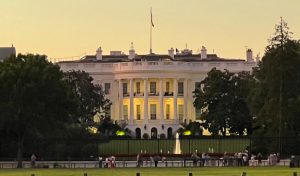 -Editorial
-Editorial
The federal government entered a shutdown at midnight after lawmakers and the White House did not strike a last-minute agreement to keep agencies funded, thrusting hundreds of thousands of federal workers and millions of Americans who rely on government services into a new cycle of uncertainty.
The shutdown marks the first since 2019 and comes amid heightened partisan conflict over federal spending priorities. The Office of Management and Budget instructed agencies late Tuesday to begin carrying out contingency plans, halting operations considered “nonessential” and reducing staff to skeleton levels in departments across Washington and beyond.
According to the Partnership for Public Service, 900,000 federal employees are expected to be furloughed, while an added 700,000 will continue working without pay until Congress passes a funding measure. Some agencies face near-total shutdowns, including the Environmental Protection Agency, which plans to furlough 89 percent of its staff, and the Department of Education, where more than 2,000 employees will be sent home. National parks and museums are expected to close, while military service members will remain on duty without pay.
President Donald Trump placed the blame squarely on Democrats, telling reporters Tuesday night that Senate leaders “want to shut down the country,” accusing them of blocking Republican-backed spending legislation. Democrats countered that the White House had insisted on deep domestic cuts while stripping away health insurance subsidies and rescinding billions in foreign aid, proposals they said were unacceptable.
The shutdown follows months of failed negotiations. After approving temporary spending bills earlier this year, lawmakers entered September with major disagreements unresolved. Senate Democrats pushed for an extension that included health care subsidies, while House Republicans advanced a narrower plan backed by the Trump administration. Both proposals failed on the Senate floor on Tuesday.
Vice President J.D. Vance said the shutdown was inevitable, blaming Democrats for refusing to accept what he described as “basic” spending limits. Senate Minority Leader Chuck Schumer and House Minority Leader Hakeem Jeffries, who met with Trump at the White House on Monday in a final effort to avert the lapse, said the administration had refused to negotiate in good faith.
The shutdown will have sweeping consequences across the country. Federal courts and immigration enforcement operations will continue, though delays are expected. The Department of Agriculture will pause several services, and the Women, Infants, and Children nutrition program, known as WIC, could see payments delayed. The Centers for Disease Control and Prevention and the National Institutes of Health will furlough generous portions of their workforce, limiting research, grant reviews, and public health communications.
Economic analysts warned that the shutdown could ripple quickly into financial markets. The Department of Labor and the Department of Commerce have already announced the suspension of key data releases from the Bureau of Labor Statistics and the Census Bureau. The U.S. dollar and Treasury securities dipped ahead of the deadline as investors braced for prolonged disruption. Contractors, unlike federal employees, will not receive back pay, leaving private firms that depend on government contracts facing immediate losses.
The political fallout is still uncertain. A poll conducted by NPR found 38 percent of Americans blamed Republicans for the shutdown, compared with 27 percent who blamed Democrats and 31 percent who held both parties responsible. Independent voters were most likely to fault both sides equally.
The roots of the standoff stretch back to earlier this year when Democrats reluctantly backed a short-term extension to avert a March shutdown. That measure expired at the end of September, and with both parties hardened in their positions, the impasse proved insurmountable. Disputes over foreign aid rescissions, domestic health spending, and presidential authority in setting funding priorities have dominated the talks.
House Speaker Mike Johnson said he would keep the chamber in session until an agreement is reached but offered no timetable for fresh negotiations. Senate leaders signaled they were prepared to consider another stopgap measure if the White House would accept it. For now, federal employees, contractors, and Americans dependent on government programs are left waiting for clarity on how long the standoff will last.


